China Insight
Another University Murder: Time To Get Serious About Dorm Life Problems?
A recent Sichuan university murder case has shocked China’s netizens. As one of the most heinous campus crimes in China’s recent history, it has attracted much public discussion about the underlying factors that played a role in the murder. Is it time for Chinese universities to get more serious about its dormlife problems?
Published
8 years agoon
By
Diandian Guo
A recent Sichuan university murder case has shocked China’s netizens. As one of the most heinous campus crimes in China’s recent history, it has attracted much public discussion about the underlying factors that played a role in the murder. Is it time for Chinese universities to get more serious about its dorm life problems?
On the 27th of March, Lu, a 20-year-old art student in a university in Chengdu (Sichuan), was brutally killed and beheaded in his dormitory. Two weeks later, on April 15, a regional branch of Chengdu Police Bureau confirmed to local media that the case was solved and that the suspect, Teng, was placed under arrest. A psychiatric evaluation has been ordered for him.
“March 28 is a day that will be engraved in my mind forever”
According to fellow roommates, Lu and Teng had an altercation on March 26. Lu was singing in their dormitory that night, which reportedly annoyed Teng. When their conflict became physical, the other boys took them apart. The following night, Teng returned to the dorm room with a cooking knife and asked Lu to come out.
Lu’s body was later found in the study area of his dormitory building. As reported by several media, Lu had been stabbed over 50 times and was then decapitated by his roommate. Lu’s brother told The Paper that his younger’s brother’s body was so mutilated after the attack that it had cost 18,000 RMB (±2800 US$) to reattach the body parts by stitching.
While the case is still under court procedure, the victim’s brother has opened a Sina Weibo account to advocate justice for Lu: “Netizen friends, hello,” he wrote on April 18: “I am Lu Haiqiang, the brother of the victim of the 3.28 campus murder case. I first want to thank you for following this case. March 28 2016 is a day that will be engraved in my mind forever..”
“I cannot sleep with all this noise”
Meanwhile, the suspect Teng has admitted to the murder and the police has agreed to psychiatric evaluation. Results of this evaluation will be released in late April or early May. Teng’s mother reportedly said that her son had done two suicide attempts when he was still in high school by cutting his wrists. His family has been seeking psychological help for their son ever since.
Further investigation is needed to establish whether Teng was mentally disturbed at the time of the crime. Teng’s family does not know what caused their son to commit such a heinous crime, but the mother stated that during his first year at university, the boy had called home to complain about dormitory life, saying: “It’s too noisy here at night, all this farting and snoring. I cannot sleep with all this noise.”
“The Fellow that Sleeps on the Bunk above Mine”
What turned a seemingly trivial fight into a matter of life and death? At the base of Teng and Lu’s was a disagreement about the proper use of their shared living space. With half a dozen youngsters living together in a compacted room, China’s campus life is not always easy.
Most universities in China provide on-campus dormitories for their students. A dorm room is often around 20-30 square meters, with bunk beds, tables and wardrobes in the living area. A toilet is included in some cases. For undergraduates, usually 4-8 people live together in one room. Students will be randomly allotted a dormitory at the beginning of their campus life, often sharing with fellow students of the same major or department.
For many students, the dormitory is like their first social environment, second home, and third classroom. Besides sleeping there, students on average spend 5-7 hours in their dorm. Roommates often get along well and end up being friends for life. Chinese folk singer Laolang has a famous song about this kind of roommate friendship, titled The Fellow that Sleeps on the Bunk above Mine (睡在我上铺的兄弟).
Dorm life is not all roses
But dorm life is not all roses. A group of grown-ups living together in a compacted space without knowing each other too well can cause problematic situations. A 2010 survey of 850 university students in Hebei province showed that almost 60% of students were not content with their dorm life; nearly a quarter said they didn’t want to live with their current roommates if they had the choice. Apart from the generally poor living conditions, frictions among roommates are often a source of complaint.
Different backgrounds, peculiar personal habits, certain personalities, and even the social life of each individual can become a cause of disagreement amongst roommates. In a survey of Chengdu universities, 60% of participants said they disliked one or more persons in their dorm.
[rp4wp]
Living together with total strangers can be a challenge in itself, but is extra strenuous for China’s single-child generation, who never had to share their space with brothers or sisters. Leaving the comfort of their parents’ home, university dorm life is their first experience of a shared living space. Small things like eating habits and one’s daily rhythm can suddenly become the reason for troubled dorm relations, causing much stress for those involved. For students who are already mentally unstable, this might worsen their condition.
While most conflicts stop at cold words or small mischiefs, they sometimes get out of hand. In 2004, biochemistry student Ma Jiajue at China’s Yunnan University killed four of his roommates. He said he hated the victims because they didn’t treat him as a friend.
In 2013, a Fudan student died of drinking from a poisoned water cooler. A fellow medical student who had trivial conflicts with the victim had purposely poisoned it. That same year, in Nanjing, a boy killed his roommate for disturbing him when playing his video game – showing how trivial matters can lead to extreme aggression.
Time for universities to step up?
Under the hashtag of ‘Sichuan Normal University Murder Case’ (#四川师范大学杀人案#), thousands of Weibo netizens have been discussing the murder on Lu. One netizen says: “Looking at this murder case, I’d like to raise again that some things about dorm life require attention. I hope people will start to understand this, so that problems can be dealt with in time.”
There are few alternatives for those unhappy with their dormitory life. Students who live close to their hometowns can move back to their parents’ place; but many students attend university in cities that are far from their family. Renting an own place is often difficult and expensive, especially in big cities. In some cases, students are lucky and can switch to another dorm. Psychological help for students suffering from the pressures of dorm life is often unavailable, and long-term stress can negatively influence study results.
Extensive exposure to irritation and low chances of changing the situation makes dormitory conflicts an important source of psychological stress amongst students. According to an article by a Chinese school psychologist, 45% of his 200 consultancies in 3 years concern problems in dorms. According to the article, the solution to China’s dorm problem is in the students’ hands: they have to divert their attention, put themselves in the shoes of their roommates, and clearly communicate with each other.
“How to avoid getting murdered in your dorm”
On Weibo, the recent murder case has seemed to raise more awareness on preserving the peace amongst dorm students. According to a Sina Weibo post on how to live a better dorm life, student’s suggestions are small and simple: make sure to be quiet when others are sleeping, use earphones when listening to music, clean up your things and do not use each other’s things without asking.
But sometimes seemingly simple solutions are easier said than done. Apart from encouraging students to solve their own dorm problems, it is time for universities to step up. Acknowledging that the downsides of dormitory life can lead to serious problems is a first step. Students need help and support in dealing with their dorm troubles. This kind of guidance would also allow school authorities to detect problems before they get out of hand.
China’s dormitory system is unlikely to undergo significant change in the coming years due to China’s population density and increasing university intake. But universities could lighten some pressure by showing more flexibility and giving students a chance to change into another dorm if their current situation shows no signs of improvement.
Although little research has been done on whether university dorm living conditions actually heighten the risk of conflict, the many shocking tragedies that China’s universities have seen over the past decade are a clear sign that the potential downsides of dorm life require more social attention. By now, the hashtag ‘how to avoid getting murdered in your dorm’ (#如何避免在宿舍被杀#) is gaining popualiriy on social media. However crude it may be, it might be a first step in opening the discussion on a safer and more pleasant dorm life.
– By Diandian Guo
Read more on crime in dormitories
http://www.china.org.cn/chinese/2013-04/22/content_28621559.htm
https://en.wikipedia.org/wiki/Yao_Jiaxin_murder_case
Read more on dormitory lives of Chinese university students
许传新,大学生宿舍人际关系质量研究,《当代青年研究》2004(4): 6-9
曹加平,大学生宿舍人际冲突原因与对策分析,《江苏大学学报·高教研究版》2006, 28(2):27-30
Featured images: (left) the murder scene – study room in a dormitory building, blocked after the crime. Pictures from The Paper (澎湃新闻). (right) ordinary dorm room in Chinese university.
Additional editing by Manya Koetse
©2016 Whatsonweibo. All rights reserved. Do not reproduce our content without permission – you can contact us at info@whatsonweibo.com.
Diandian Guo is a China-born Master student of transdisciplinary and global society, politics & culture at the University of Groningen with a special interest for new media in China. She has a BA in International Relations from Beijing Foreign Language University, and is specialized in China's cultural memory.

China Brands, Marketing & Consumers
More than Malatang: Tianshui’s Recipe for Success
Zibo had its BBQ moment. Now, it’s Tianshui’s turn to shine with its special take on malatang. Tourism marketing in China will never be the same again.
Published
4 weeks agoon
April 1, 2024
Since the early post-pandemic days, Chinese cities have stepped up their game to attract more tourists. The dynamics of Chinese social media make it possible for smaller, lesser-known destinations to gain overnight fame as a ‘celebrity city.’ Now, it’s Tianshui’s turn to shine.
During this Qingming Festival holiday, there is one Chinese city that will definitely welcome more visitors than usual. Tianshui, the second largest city in Gansu Province, has emerged as the latest travel hotspot among domestic tourists following its recent surge in popularity online.
Situated approximately halfway along the Lanzhou-Xi’an rail line, this ancient city wasn’t previously a top destination for tourists. Most travelers would typically pass through the industrial city to see the Maiji Shan Grottoes, the fourth largest Buddhist cave complex in China, renowned for its famous rock carvings along the Silk Road.
But now, there is another reason to visit Tianshui: malatang.
Gansu-Style Malatang
Málàtàng (麻辣烫), which literally means ‘numb spicy hot,’ is a popular Chinese street food dish featuring a diverse array of ingredients cooked in a soup base infused with Sichuan pepper and dried chili pepper. There are multiple ways to enjoy malatang.
When dining at smaller street stalls, it’s common to find a selection of skewered foods—ranging from meats to quail eggs and vegetables—simmering in a large vat of flavorful spicy broth. This communal dining experience is affordable and convenient for solo diners or smaller groups seeking a hotpot-style meal.
In malatang restaurants, patrons can usually choose from a selection of self-serve skewered ingredients. You have them weighed, pay, and then have it prepared and served in a bowl with a preferred soup base, often with the option to choose the level of spiciness, from super hot to mild.
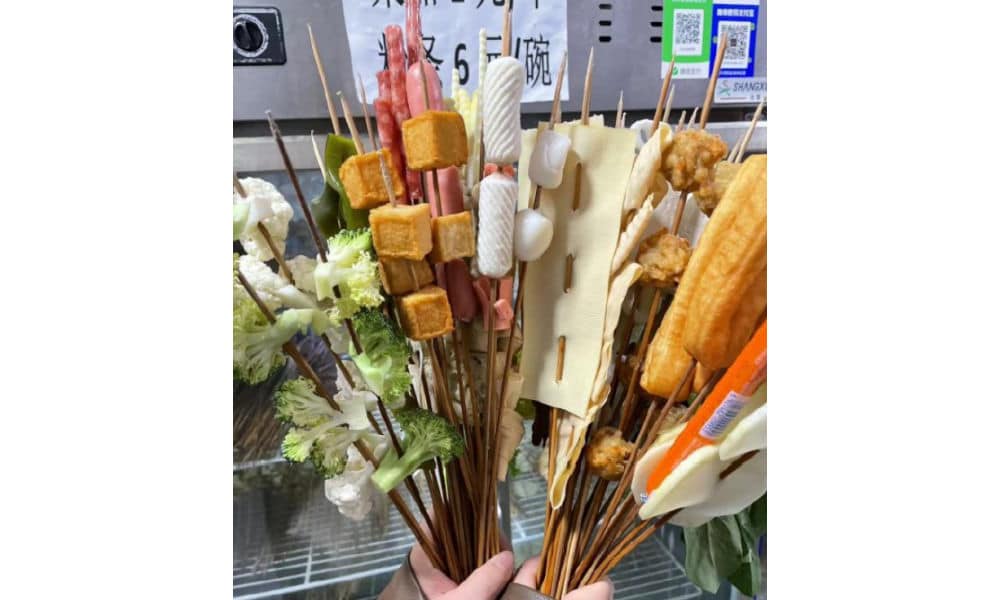
Although malatang originated in Sichuan, it is now common all over China. What makes Tianshui malatang stand out is its “Gansu-style” take, with a special focus on hand-pulled noodles, potato, and spicy oil.
An important ingredient for the soup base is the somewhat sweet and fragrant Gangu chili, produced in Tianshui’s Gangu County, known as “the hometown of peppers.”
Another ingredient is Maiji peppercorns (used in the sauce), and there are more locally produced ingredients, such as the black fungi from Qingshui County.

One restaurant that made Tianshui’s malatang particularly famous is Haiying Malatang (海英麻辣烫) in the city’s Qinzhou District. On February 13, the tiny restaurant, which has been around for three decades, welcomed an online influencer (@一杯梁白开) who posted about her visit.
The vlogger was so enthusiastic about her taste of “Gansu-style malatang,” that she urged her followers to try it out. It was the start of something much bigger than she could have imagined.
Replicating Zibo
Tianshui isn’t the first city to capture the spotlight on Chinese social media. Cities such as Zibo and Harbin have previously surged in popularity, becoming overnight sensations on platforms like Weibo, Xiaohongshu, and Douyin.
This phenomenon of Chinese cities transforming into hot travel destinations due to social media frenzy became particularly noteworthy in early 2023.
During the Covid years, various factors sparked a friendly competition among Chinese cities, each competing to attract the most visitors and to promote their city in the best way possible.
The Covid pandemic had diverse impacts on the Chinese domestic tourism industry. On one hand, domestic tourism flourished due to the pandemic, as Chinese travelers opted for destinations closer to home amid travel restrictions. On the other hand, the zero-Covid policy, with its lockdowns and the absence of foreign visitors, posed significant challenges to the tourism sector.
Following the abolition of the zero-Covid policy, tourism and marketing departments across China swung into action to revitalize their local economy. China’s social media platforms became battlegrounds to capture the attention of Chinese netizens. Local government officials dressed up in traditional outfits and created original videos to convince tourists to visit their hometowns.
Zibo was the first city to become an absolute social media sensation in the post-Covid era. The old industrial and mining city was not exactly known as a trendy tourist destination, but saw its hotel bookings going up 800% in 2023 compared to pre-Covid year 2019. Among others factors contributing to its success, the city’s online marketing campaign and how it turned its local BBQ culture into a unique selling point were both critical.

Zibo crowds, image via 163.com.
Since 2023, multiple cities have tried to replicate the success of Zibo. Although not all have achieved similar results, Harbin has done very well by becoming a meme-worthy tourist attraction earlier in 2024, emphasizing its snow spectacle and friendly local culture.
By promoting its distinctive take on malatang, Tianshui has emerged as the next city to captivate online audiences, leading to a surge in visitor numbers.
Like with Zibo and Harbin, one particular important strategy used by these tourist offices is to swiftly respond to content created by travel bloggers or food vloggers about their cities, boosting the online attention and immediately seizing the opportunity to turn online success into offline visits.
A Timeline
What does it take to become a Chinese ‘celebrity city’? Since late February and early March of this year, various Douyin accounts started posting about Tianshui and its malatang.
They initially were the main reason driving tourists to the city to try out malatang, but they were not the only reason – city marketing and state media coverage also played a role in how the success of Tianshui played out.
Here’s a timeline of how its (online) frenzy unfolded:
- July 25, 2023: First video on Douyin about Tianshui’s malatang, after which 45 more videos by various accounts followed in the following six months.
- Feb 5, 2024: Douyin account ‘Chuanshuo Zhong de Bozi’ (传说中的波仔) posts a video about malatang streetfood in Gansu
- Feb 13, 2024: Douyin account ‘Yibei Liangbaikai’ (一杯梁白开) posts a video suggesting the “nationwide popularization of Gansu-style malatang.” This video is an important breakthrough moment in the success of Tianshui as a malatang city.
- Feb – March ~, 2024: The Tianshui Culture & Tourism Bureau is visiting sites, conducting research, and organizing meetings with different departments to establish the “Tianshui city + malatang” brand (文旅+天水麻辣烫”品牌) as the city’s new “business card.”
- March 11, 2024: Tianshui city launches a dedicated ‘spicy and hot’ bus line to cater to visitors who want to quickly reach the city’s renowned malatang spots.
- March 13-14, 2024: China’s Baidu search engine witnesses exponential growth in online searches for Tianshui malatang.
- March 14-15, 2024: The boss of Tianshui’s popular Haiying restaurant goes viral after videos show him overwhelmed and worried he can’t keep up. His facial expression becomes a meme, with netizens dubbing it the “can’t keep up-expression” (“烫不完表情”).
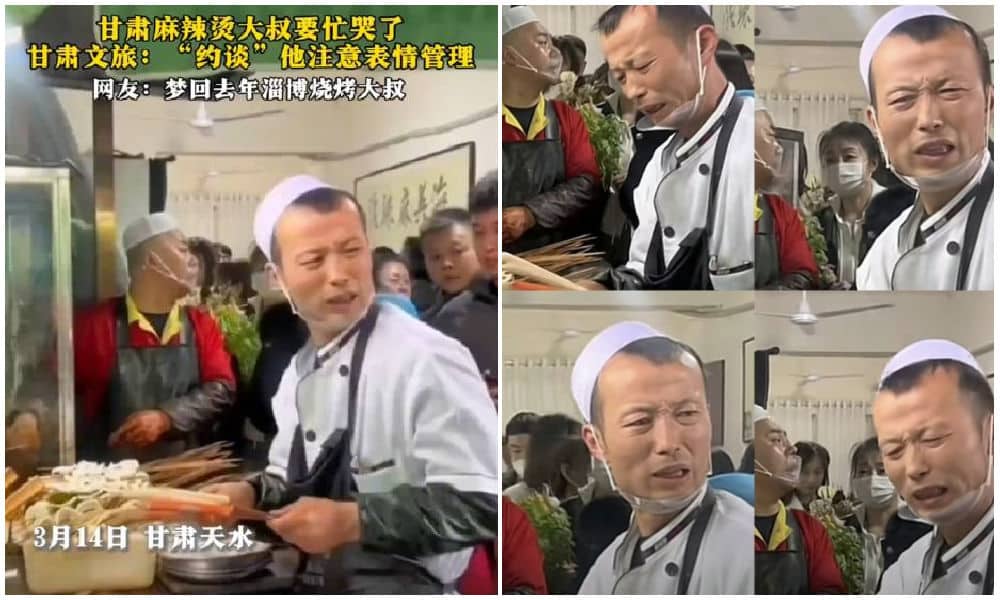
The worried and stressed expression of this malatang diner boss went viral overnight.
- March 17, 2024: Chinese media report about free ‘Tianshui malatang’ wifi being offered to visitors as a special service while they’re standing in line at malatang restaurants.
- March 18, 2024: Tianshui opens its first ‘Malatang Street’ where about 40 stalls sell malatang.
- March 18, 2024: Chinese local media report that one Tianshui hair salon (Tony) has changed its shop into a malatang shop overnight, showing just how big the hype has become.
- March 21, 2024: A dedicated ‘Tianshui malatang’ train started riding from Lanzhou West Station to Tianshui (#天水麻辣烫专列开行#).
- March 21, 2024: Chinese actor Jia Nailiang (贾乃亮) makes a video about having Tianshui malatang, further adding to its online success.
- March 30, 2024: A rare occurrence: as the main attraction near Tianshui, the Maiji Mountain Scenic Area announces that they’ve reached the maximum number of visitors and don’t have the capacity to welcome any more visitors, suspending all ticket sales for the day.
- April 1, 2024: Chinese presenter Zhang Dada was spotted making malatang in a local Tianshui restaurant, drawing in even more crowds.
A New Moment to Shine
Fame attracts criticism, and that also holds true for China’s ‘celebrity cities.’
Some argue that Tianshui’s malatang is overrated, considering the richness of Gansu cuisine, which offers much more than just malatang alone.
When Zibo reached hype status, it also faced scrutiny, with some commenters suggesting that the popularity of Zibo BBQ was a symptom of a society that’s all about consumerism and “empty social spectacle.”
There is a lot to say about the downsides of suddenly becoming a ‘celebrity city’ and the superficiality and fleetingness that comes with these kinds of trends. But for many locals, it is seen as an important moment as they see their businesses and cities thrive.
Even after the hype fades, local businesses can maintain their success by branding themselves as previously viral restaurants. When I visited Zibo a few months after its initial buzz, many once-popular spots marketed themselves as ‘wanghong’ (网红) or viral celebrity restaurants.
For the city itself, being in the spotlight holds its own value in the long run. Even after the hype has peaked and subsided, the gained national recognition ensures that these “trendy” places will continue to attract visitors in the future.
According to data from Ctrip, Tianshui experienced a 40% increase in tourism spending since March (specifically from March 1st to March 16th). State media reports claim that the city saw 2.3 million visitors in the first three weeks of March, with total tourism revenue reaching nearly 1.4 billion yuan ($193.7 million).
There are more ripple effects of Tianshui’s success: Maiji Shan Grottoes are witnessing a surge in visitors, and local e-commerce companies are experiencing a spike in orders from outside the city. Even when they’re not in Tianshui, people still want a piece of Tianshui.
By now, it’s clear that tourism marketing in China will never be the same again. Zibo, Harbin, and Tianshui exemplify a new era of destination hype, requiring a unique selling point, social media success, strong city marketing, and a friendly and fair business culture at the grassroots level.
While Zibo’s success was largely organic, Harbin’s was more orchestrated, and Tianshui learned from both. Now, other potential ‘celebrity’ cities are preparing to go viral, learning from the successes and failures of their predecessors to shine when their time comes.
By Manya Koetse
Independently reporting China trends for over a decade. Like what we do? Support us and get the story behind the hashtag by subscribing:
Spotted a mistake or want to add something? Please let us know in comments below or email us. First-time commenters, please be patient – we will have to manually approve your comment before it appears.
©2024 Whatsonweibo. All rights reserved. Do not reproduce our content without permission – you can contact us at info@whatsonweibo.com.
China Brands, Marketing & Consumers
In Hot Water: The Nongfu Spring Controversy Explained
Nongfu and nationalists: how the praise for one Chinese domestic water bottle brand sparked online animosity toward another.
Published
1 month agoon
March 14, 2024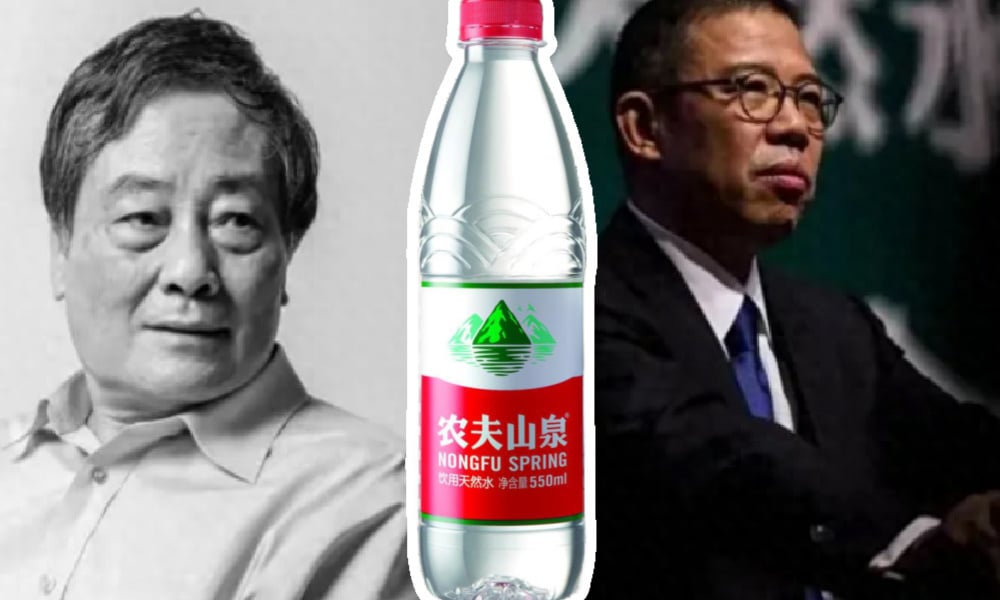
PREMIUM CONTENT
The big battle over bottled water has taken over Chinese social media recently. The support for the Chinese Wahaha brand has morphed into an anti-Nongfu Spring campaign, led by online nationalists.
Recently, China’s number one water brand, Nongfu Spring (农夫山泉) has found itself in the midst of an online nationalist storm.
The controversy started with the passing of Zong Qinghou (宗庆后), the founder and chairman of Wahaha Group (娃哈哈集团), the largest beverage producer in China. News of his passing made headlines on February 25, 2024, with one Weibo hashtag announcing his death receiving over 900 million views (#宗庆后逝世#).
The death of the businessman led to an outpouring of emotions on Weibo, where netizens praised his work ethic, dedication, and unwavering commitment to his principles.

Zong Qinghou, image via Weibo.
Born in 1945, Zong established Wahaha in Hangzhou in 1987, starting from scratch alongside two others. Despite humble beginnings, Zong, who came from a poor background, initially sold ice cream and soft drinks from his tricycle. However, by the second year, the company achieved success by concentrating on selling nutritional drinks to children, a strategy that resonated with Chinese single-child families (Tsui et al., 2017, p. 295).
The company experienced explosive growth and, boasting over 150 products ranging from milk drinks to fruit juices and soda pops, emerged as a dominant force in China’s beverage industry and the largest domestic bottled-water company.

Big bottle of Wahaha (meaning “laughing child”) water.
The admiration for Zong Qinghou and his company relates to multiple factors. Zong was loved for his inspirational rags-to-riches story under China’s economic reform, not unlike the self-made Tao Huabi and her Laoganma brand.
He was also loved for establishing a top Chinese national brand and refusing to be bought out. A decade after Wahaha partnered with the France-based multinational Danone in 1996, the two companies clashed when Zong accused Danone of trying to take over the Wahaha brand, which turned into a high-profile legal battle that was eventually settled in 2009, when Danone eventually sold all its stakes.
It is one of the reasons why Zong was known as a “patriotic private entrepreneur” (爱国民营企业家) who remained devoted to China and his roots.
Netizens also admire the Chinese tycoon’s modesty and humility despite his immense wealth. He would often wear simple cloth shoes and, apparently not caring much about the elite social stratum, allegedly declined invitations to dine with Bill Gates and the Queen of England. He had a people-centric business approach. He prioritized the welfare of Wahaha employees, ensuring the protection of pensions for retired workers, establishing an employee stock ownership plan, and refused to terminate employees older than 45.
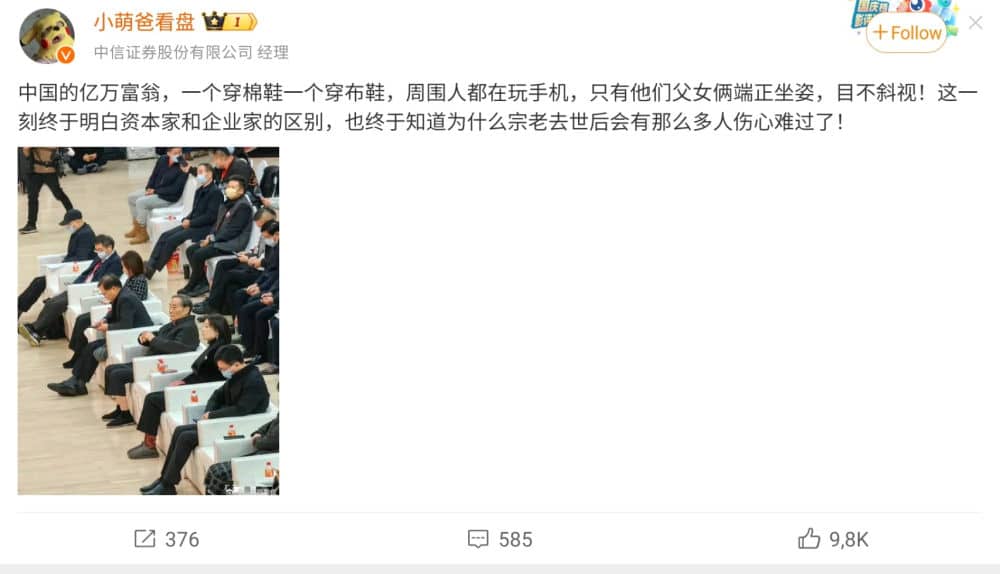
A post praising Zong and his daughter for staying humble despite their wealth: wearing simple shoes and not looking at their phones.
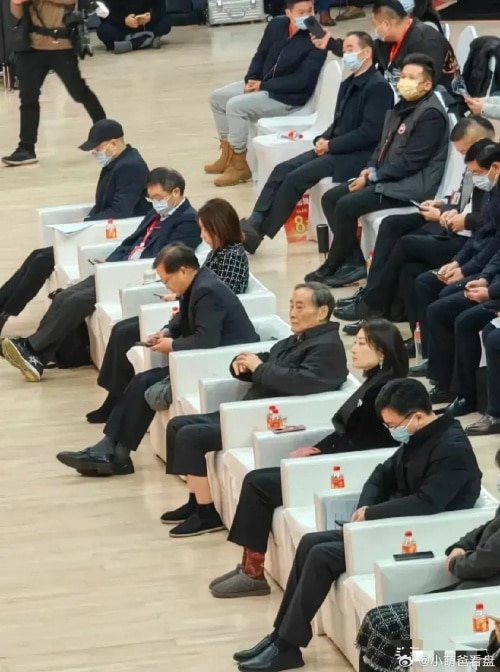
Zong and his daughter stand out due to their simple shoes.
As a tribute to Zong following his passing in late February, people not only started buying Wahaha bottled water, they also initiated criticism against its major competitor, Nongfu Spring (农夫山泉). Posts across various Chinese social media platforms, from Douyin to Weibo, started to advocate for boycotting Nongfu as a means to “protect” Wahaha as a national, proudly made-in-China brand.
From Love for Wahaha to Hate for Nongfu
With the death of Zong Qinghou, it seems that the decades-long rivalry between Nongfu and Wahaha has suddenly taken center stage in the public opinion arena, and it’s clear who people are rooting for.
The founder and chairman of Nongfu Spring is Chinese entrepreneur Zhong Shanshan (钟睒睒), and he is perhaps less likeable than Zong Qinghou, in part because he is not considered as patriotic as him.
Born in 1954, Zhong Shanshan is a former journalist who started working for Wahaha in the early 1990s. He established his own company and started focusing on bottled water in 1996. He would become China’s richest man.
His wealth was not just accumulated because of his Nongfu Spring water, which would become a leader in China’s bottled water market. Zhong also became the largest shareholder of Wantai Biological Pharmacy Enterprise, which experienced significant growth following its IPO. Cecolin, a vaccine against human papillomavirus (HPV), is manufactured by Innovax, a wholly owned subsidiary of Wantai.

Zhong Shanshan, image via Sohu.
The fact that Zhong Shanshan previously worked for Zong Qinghou and later ventured out on his own does not cast him in a positive light, especially in the context of netizens mourning Zong. Many people perceive Zhong Shanshan as a profit-driven businessman who lacks humility and national spirit compared to his former boss. Some even label him as ‘ungrateful.’
By now, the support for Wahaha water has snowballed into an anti-Nongfu campaign, resulting in intense scrutiny and criticism directed at the brand and its owner. This has led to a significant boycott and a sharp decline in sales.
Netizens are finding multiple reasons to attack Nongfu Spring and its owner. Apart from accusing Zhong Shanshan of being ungrateful, one of the Nongfu brand’s product packaging designs has also sparked controversy. The packaging of its Oriental Leaf Green Tea has been alleged to show Japanese elements, leading to claims of Zhong being “pro-Japan.”

Chinese social media users claim the packaging of this green tea is based on Japanese architecture instead of Chinese buildings.
Another point of ongoing contention is the fact that Zhong’s son (his heir, Zhong Shuzi 钟墅子) holds American citizenship. This has sparked anger among netizens who question Zhong’s allegiance to China. Concerned that the future of Nongfu might be in the US instead of China, they accuse Zhong and his business of betraying the Chinese people and being unpatriotic.
But what also plays a role in this, is how Zhong and the Nongfu Spring PR team have responded to the ongoing criticism. Some bloggers (link, link) argue their approach lacks emotional connection and comes off as too business-like.
On March 3rd, Zhong himself issued a statement addressing the personal attacks he faced following the passing of Zong Qinghou. In his article (我与宗老二三事), he aimed to ‘set the record straight.’ Although he expressed admiration for Zong Qinghou, many found his piece to be impersonal and more focused on safeguarding his own image.
The same criticism goes for the company’s response to the “pro-Japan” issue. On March 7, they refuted ongoing accusations and stated that the architecture depicted on the controversial beverage packaging was inspired by Chinese temples, not Japanese ones, and that a text on the bottle is about Japanese tea culture originating from China.
Calls for Calmer Water
Although Weibo and other social media platforms in China have recently seen a surge in nationalism, not everybody agrees with the way Nongfu Spring is being attacked. Some say that netizens are taking it too far and that a vocal minority is controlling the trending narrative.
Posts or videos from people pouring out Nongfu water in their sink are countered by others from people saying that they are now buying the brand to show solidarity in the midst of the social media storm.

Online photo of netizen buying Nongfu Spring water: “I support Nongfu Spring, I support private entrepreneurs, I support the recovery of China’s economy. I firmly opposo populism running wild.”
While more people are speaking out against the recent waves of nationalism, news came in on March 13 that the 95-year-old mother of Zhong Shanshan had passed away. According to an obituary published in the Qianjiang Evening News newspaper, Guo Jin (郭瑾) passed away on March 11.
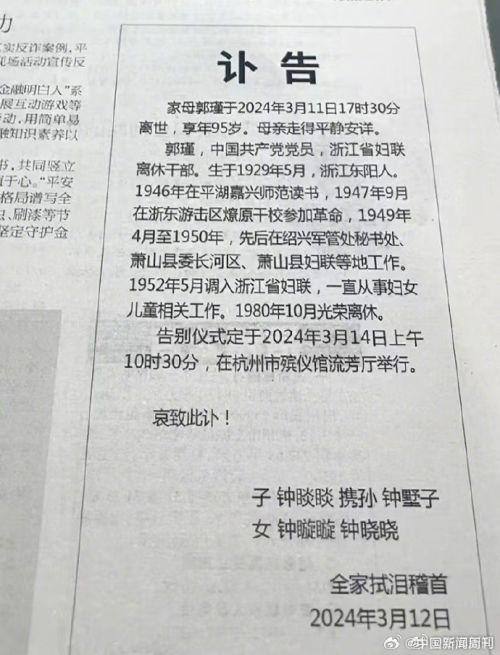
The obituary.
A screenshot of a WeChat post alleged to be written by Zhong Shanshan made its rounds, in which Zhong blamed the online hate he received, and the ensuing stress, for his mother’s death.

While criticism of Zhong resurfaced for attributing the old lady’s death to “indescribable cyberbullying” (“莫名网暴”), some saw this moment as an opportunity to bring an end to the attacks on Nongfu. As the controversy continued to brew, the Sina Weibo platform seemingly attempted to divert attention by removing some hashtags related to the issue (e.g., “Zhong Shanshan’s Mother Guo Jin Passed Away” #钟睒睒之母郭瑾离世#).
The well-known Chinese commentator Hu Xijin (胡锡进) also spoke out in support of Nongfu Spring and called for rationality, arguing that Chinese private entrepreneurs are facing excessive scrutiny. He suggested that China’s netizens should stop nitpicking over their private matters and instead focus more on their contributions to the country’s economy.
Others are also calling for an end to the waves of attacks towards Nongfu and Zhong Shanshan. Chinese entrepreneur Li Guoqing (李国庆), co-founder of the e-commerce company Dangdang (once hailed as the ‘Amazon of China’), posted a video about the issue on March 12. He said: “These two [Nongfu Spring and Wahaha brands] have come a long way to get to where they are today. The fact that they are competitors is a good thing. If old Zong [Qinghou] were still alive today and saw this division, he would surely step forward and tell people to get back to business and rational competition.”

Li Guoqing in his video (since deleted).
Li also suggested that Zong’s heir, his daughter Kelly Zong, should come out, broaden her perspective, and settle the matter. She should thank netizens for their support, he argued, and tell them that it is completely unnecessary to exacerbate the rift with Nongfu Spring in showing their support.
But those mingling in the matter soon discover themselves how easy it is to get your fingers burned on this hot topic. Li Guoqing might have meant well, but he also faced attacks after his video. Not only because people feel he is putting Kelly Zong in an awkward position, but also because his own son. like Zhong Shuzi, allegedly holds American citizenship. Perhaps unwilling to find himself in hot water as well, Li Guoqing has since deleted his video. The Nongfu storm may be one that should blow over by itself.
By Manya Koetse
With contributions by Miranda Barnes
References
Tsui, Anne S., Yingying Zhang, Xiao-Ping Chen. 2017. “Chinese Companies Need Strong and Open-minded Leaders. Interview with Wahaha Group Founder, Chairman and CEO, Qinghou Zong.” In Leadership of Chinese Private Enterprises
Insights and Interviews, Palgrave MacMillan.
Get the story behind the hashtag. Subscribe to What’s on Weibo here to receive our newsletter and get access to our latest articles:
Spotted a mistake or want to add something? Please let us know in comments below or email us. First-time commenters, please be patient – we will have to manually approve your comment before it appears.
©2024 Whatsonweibo. All rights reserved. Do not reproduce our content without permission – you can contact us at info@whatsonweibo.com.
Subscribe

Weibo Watch: The Battle for the Bottom Bed

Zara Dress Goes Viral in China for Resemblance to Haidilao Apron

“Old Bull Eating Young Grass”: 86-Year-Old Chinese Painter Fan Zeng Marries 36-Year-Old Xu Meng

Chengdu Disney: The Quirkiest Hotspot in China

Where to Eat and Drink in Beijing: Yellen’s Picks

The ‘Two Sessions’ Suggestions: Six Proposals Raising Online Discussions

Top 9 Chinese Movies to Watch This Spring Festival Holiday

Party Slogan, Weibo Hashtag: “The Next China Will Still Be China”

From Pitch to Politics: About the Messy Messi Affair in Hong Kong (Updated)

Looking Back on the 2024 CMG Spring Festival Gala: Highs, Lows, and Noteworthy Moments

Two Years After MU5735 Crash: New Report Finds “Nothing Abnormal” Surrounding Deadly Nose Dive

More than Malatang: Tianshui’s Recipe for Success

“Old Bull Eating Young Grass”: 86-Year-Old Chinese Painter Fan Zeng Marries 36-Year-Old Xu Meng

In Hot Water: The Nongfu Spring Controversy Explained

Chengdu Disney: The Quirkiest Hotspot in China
Get in touch
Would you like to become a contributor, or do you have any tips or suggestions? Get in touch here!
Popular Reads
-

 China Insight2 months ago
China Insight2 months agoThe ‘Two Sessions’ Suggestions: Six Proposals Raising Online Discussions
-

 China Arts & Entertainment3 months ago
China Arts & Entertainment3 months agoTop 9 Chinese Movies to Watch This Spring Festival Holiday
-

 China Media2 months ago
China Media2 months agoParty Slogan, Weibo Hashtag: “The Next China Will Still Be China”
-

 China World2 months ago
China World2 months agoFrom Pitch to Politics: About the Messy Messi Affair in Hong Kong (Updated)





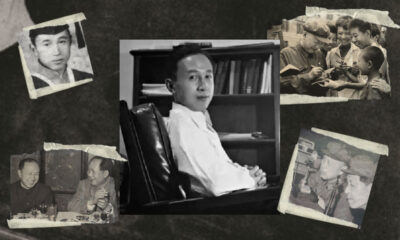


Rob
April 23, 2016 at 1:57 am
One of the issues that keeps students from going for help is the fear that they will be black-listed in some fashion by admin. I know that my students would not go to the counselling department or department heads because (a) they were made to feel that they were being a burden, (b) they feared getting in trouble, and (c) there was no real privacy. The minute a student spoke with the fudaoyuan at our school, their details were disseminated throughout the department to every teacher, and the standard response was to simply walk on eggshells around the students and go easy on them so they wouldn’t commit suicide. There really is no impetus from the school to actually treat the issue; they simply want to avoid any collapse until such time as the students are no longer their responsibility.
There comes a time when the schools have to take responsibility and actually deal with the issues they help to create rather than avoid them or pretend they are not there.
Diandian GUO
April 24, 2016 at 7:11 pm
Hi Rob! When a university student, I experienced the exact thing you described. Teachers in my department were reluctant to tackle a dormitory problem where one boy seemed to be disturbed, unstable and had intentions to hurt. In the end the boy was detained to a lower year, but he still had problems with his new room mates.
I was wondering if you have seen more cases of dormitory problems? Do you think these problems should have attracted more attention? Can bad dormitory life affect university life in general? From you words, I think you are a teacher. Do you have any thoughts on how things could be improved?
Rob
April 27, 2016 at 1:10 am
Hi DianDian,
Yes, I have worked as a teacher at a Uni in Beijing. I’ve had talks with my students who have had issues with roommates – one looked to transfer her major just to get away from her roommates; another student has indicated that one of her roommates has an issue with everyone in the dorm, so they avoid her as much as possible. It’s a challenge, absolutely, and it definitely goes unreported – as someone who is Chinese, you probably understand the cultural focus on harmony and unity and NOT rocking the boat, which also compounds the issue. The Uni I taught at even had a murder-suicide at one point (but this was attributed to the female roommates being lesbians, though I have my doubts).
Among the males, there are different issues, but they still have issues (especially among the students who are gay).
I can guarantee that an unstable living environment will definitely impact students negatively, both in terms of their studies and social interactions but also in terms of stress and depression.
As for how things can be improved – when I lived in York, we shared a living area but had private rooms, which would be a nice design for the dorm rooms, but of course, with large populations this becomes a challenge. What might be worth trying is to limit dorms to four people, and then cycle roommate groupings each year. This may increase student socializing and give them greater access to forming networks. As well, an induction teaching them to be sensitive to each others needs might be a good requirement – have students sign a contract regarding mutually respecting each other and then submit it to the fudaoyuan; if something comes up, then students can approach the fudaoyuan who can resolve the issues based on the contract/roommate agreement.
Those are just thoughts off the top of my head.